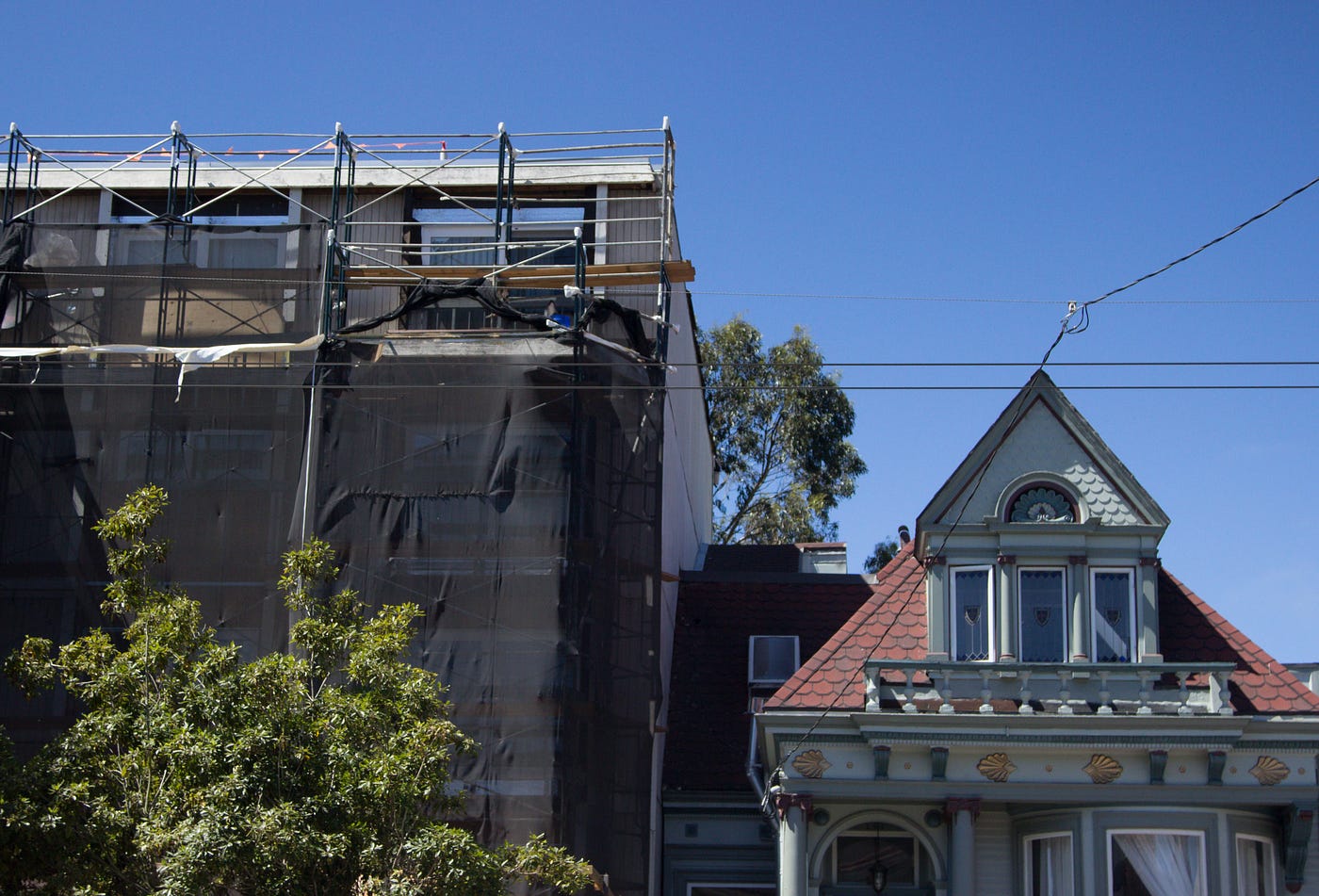
The housing market in San Francisco has been called the “least affordable in the nation.” Only 15% of the housing stock is affordable to average people, and prices are rising at such astronomical rates that even the middle class is being priced out of the city.
While all levels of government have been trying to address the crisis, the system of tax credits and targets the federal and city government have established are designed to encourage the construction of affordable housing by private developers. Given that prices continue to soar, that affordable housing remains scarce and that low-income residents are still being pushed out, it’s worth questioning whether this strategy is working, and whether we should instead be reinvesting in public housing to address the crisis.
When rent-controlled units are being lost at almost the same rate as new affordable housing is being built, there’s a fundamental problem with the strategy.
Unaffordable Private Housing
The desire to find a private solution to the housing crisis reflects how deference to the market, and the idea that anything can be done better by private companies than public entities, has come to dominate our political discourse. Significant resources are being directed toward affordable-housing construction, even though the government’s own metrics show that this approach is failing.
Between 2007 and 2014, 67% of all housing production in San Francisco was for residents with above-moderate incomes — meaning they earned 120% of the median income — and it was the only category for which the government’s target was met. By contrast, only 18% of the targeted number of moderate-income housing was built, and only 45% of the target for those with low incomes was built, leaving production deficits of 5,547 and 6,696 units, respectively.
Even though new targets have been set for the period from 2015 to 2022, the city is off to a bad start. In 2015, there was a drop of 30% in the number of new affordable units, and they made up only 17% of the total production for the year.
To make matters worse, a 2015 housing balance report showed that even though 6,559 affordable units had been built since 2005, 5,470 rent-controlled units had been lost over the same period. This should further call into question the efficacy of the city’s approach. When rent-controlled units are being lost at almost the same rate as new affordable housing is being built, there’s a fundamental problem with the strategy.
Clearly, only those with money are getting their housing needs met. While the city’s programs help encourage some development for poor residents, it’s not nearly enough, and those in the middle are being squeezed. The reason for this is quite simple: Even with the system of subsidies and building requirements, the most expensive units will always be most profitable for private developers, so they’ll always try to maximize the number of units they can build with high rents or selling prices.
An Unbalanced Market
San Francisco is setting itself up for further problems if it continues to allow a significant imbalance in the development of market-rate units to affordable units. As the population at the high end of the income scale expands, so too does the demand for workers in low-paid service positions to cater to those at the top. But with median rent being so high, a worker needs to earn $79 an hour in order to afford it, which is making it very difficult for working-class people to remain in the city.
A 2007 nexus study concluded that for every 100 market-rate condominiums added to the housing stock — which are for residents with above-moderate incomes — an additional 43.31 lower-income units would also need to be added to meet the total impact of the new service demand. It’s a bit lower for rental units — in that case, 100 additional market-rate rentals would necessitate 33.68 affordable units.
Since the study was done nearly a decade ago, and these recommendations were not implemented, the balance of housing has shifted and prices have increased, leading journalists Dyan Ruiz and Joseph Smooke to suggest that half of new housing should be affordable for those making up to the median income.
But that’s not what’s happening. For developments with 10 or more units, the city set an inclusionary requirement that 12% of the units must be affordable if they’re built on-site or 20% if they’re off-site. Proposition C, which was approved by voters in June, will add a higher requirement of 25% on-site or 33% off-site for developments with 25 or more units, but this is still below what Ruiz and Smooke believe to be necessary.
They argue that the desire to build more densely will add more to the housing stock over time, but it won’t solve the affordability crisis, because the combination of higher building costs and increased property values commanded by the multi-unit projects will continue to push prices higher.
This is particularly notable in the Mission district, where, in 2011, a two-bedroom apartment averaged $1,900 a month. But by 2012, it had increased to $3,500, and by 2014, to nearly $5,000. It’s impossible to imagine how anyone would be able to keep up when rents are increasing so rapidly.
Any push to require higher percentages of affordable housing is met with developer resistance. When a city councilor proposed a target of 30% below-market-rate housing to 70% market-rate housing, the pro-development group SPUR responded that “the math will no longer work out for developers — meaning they’ll lose money by default, so they won’t build at all.”
This crisis will never be addressed while the responsibility for building affordable homes is placed on private developers who see profitability as their primary motive.
If mandating higher percentages of affordable housing makes development uneconomical, and existing subsidy programs aren’t enticing developers to build nearly enough affordable housing to meet the needs of residents, it becomes hard to see how the government can continue to rely so heavily on private developers.
There is a solution to this problem: a significant investment in public housing not only to update existing units but to greatly expand the stock the city has available to house residents who are struggling to afford its high rents. Unfortunately, governments have ignored this option and have instead gone all-in on their plan to have private developers meet the city’s housing needs, when they already aren’t living up to expectations.
The Privatization of Public Housing
Funding for the city’s public-housing stock has languished for decades after successive cuts at the federal level, but in recent years the city and federal governments have come together to collaborate on various programs to revitalize public housing in San Francisco.
Under the newest plan, significant new investment will be used to transform the remaining three quarters of the city’s approximately 6,000 public-housing units that weren’t covered by previous programs.
Yet the federal government mandates the use of public-private partnerships to repair or rebuild public-housing projects while diversifying the communities in which they’re situated by building mixed-income housing alongside them. When the redevelopment is complete, the units fall under the control of private developers, and public housing becomes more like Section 8, a government rental-assistance program for low-income people living in private units that ensures that they pay about 30% of their income toward their rent.
All this new money being put into public housing is only to make up for decades of underfunding. Not only will it not create any new units, but the final tally could be less than what had previously been available. RAD, the newest and largest of the programs, allows a 5% reduction in the number of units without government approval and the removal of any units that are vacant for at least 24 months.
Public housing could be another tool for governments to use to address the housing crisis, but the choice to pursue what is essentially the mass privatization of public housing led writer Rachel Cohen to conclude that “RAD is an emblematic case of this era’s intensified push to use privatization in the pursuit of social goals — not because that approach is necessarily better policy, but because it is politically possible.”
What San Francisco (and many other large cities) really needs is a reinvestment in public housing that can provide truly affordable homes for the countless people who are being forced out because of astronomical rent prices that are unaffordable for the general public.
The current model to accommodate the people who live and hope to live in San Francisco simply isn’t working. Those at the top are getting their housing needs met, but everyone else is struggling to find a place to live, let alone one they can afford. This crisis will never be addressed while the responsibility for building affordable homes is placed on private developers who see profitability as their primary motive.
The city government should recognize that private developers are effective in providing luxury and market-rate housing, but when it comes to meeting the needs of the struggling people who do the jobs that keep the city running, they simply aren’t performing — and they shouldn’t be expected to. Instead of putting so much of their resources into subsidizing affordable developments, they should cancel the privatization of public housing and reallocate their funds toward renewing the units that currently exist, while planning for new development to expand the scope of public housing in the future.
This plan will be a more difficult sell politically, especially when the myth that private companies know best has been allowed to go unchallenged for so long. It will also require a reform of the San Francisco Housing Authority to ensure that it does right by public-housing residents. But the right solution shouldn’t be ignored just because it will be more challenging to bring to fruition.
San Franciscans need to decide if they want their city to become an enclave where only the rich and the upper middle class can afford to enjoy a good life, or if they want it to be a place where people from all racial, religious and class backgrounds can continue to coexist. If they choose the latter, then they must also support an expanded role for public housing in the city’s strategy to combat the affordability crisis.








